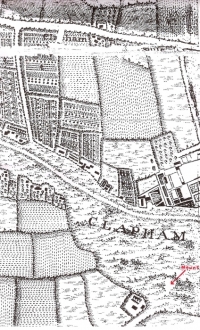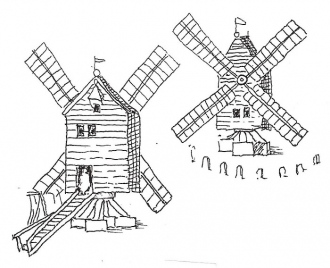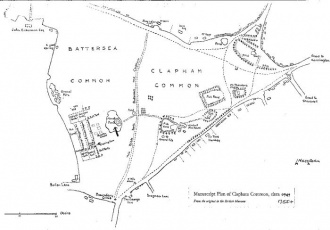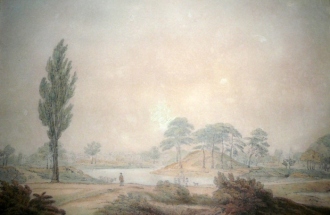The Clapham Society Local History Series 7
Mount Pond, Clapham Common:
Archaeology and History
by Michael Green RIBA FSA
PREHISTORIC BURIAL MOUND
The illustrations: Please click on thumbnail or text link to see a larger version.

In my book, Historic Clapham, I have identified a prehistoric (or possibly Anglo-Saxon) barrow field on the north-west side of Clapham Common (Fig. 1). The ditches of a string of former burial mounds were visible on the aerial photo commissioned by this writer and taken on 16.9.03 by English Heritage (NMR 21923/35). These burial mounds appear on the cartographic survey of London and the surrounding countryside ‘ten miles round’ prepared by John Rocque (ground survey 1741-5) and published in 1746. (Darlington and Howgego, 94).

To the south of these mounds is another possible barrow, clearly shown on the 1746 map (Fig. 2), in the right position for the Mount, but without the pond. It is extremely likely therefore that the Mount started life as a burial mound, the only one surviving intact in this part of south London. In the Saxon period such mounds (as identified on Wandsworth Common also), were used as boundary markers, which may well have been the case here also since Mount Pond is close to the traditional boundary of the Battersea-Clapham parishes.
There is therefore a strong case for a proper archaeological excavation of the Mount, especially since it may be designated for conservation work under proposals under consideration, at the time of writing, by Lambeth Council. English Heritage has taken a close interest in archaeological work in Clapham, and has expressed interest.
POST MEDIEVAL WINDMILL SITE
There is a strong possibility that as one of the highest points of the Common (30m.O.D.) the Mount at a later stage of its life in the post medieval period was used as the site of a windmill. In the property Extent papers of 1616 of Sir Henry Atkins, two windmills are mentioned in Clapham. The site of one of these is approximately known: it lay behind the site of the Windmill tavern on South Side. The other windmill is briefly mentioned in the 1710 boundary litigation case between Battersea and Clapham. A witness mentions that a mill stood in the vicinity of Balham Wood Lane (now Nightingale Lane) which is a short distance to the southwest of the Mount. Both windmills had been removed by the time Rocque carried out his survey 1741-5.

If indeed there was a windmill on top of the Mount it would have been of a postmill type (Fig.3): taken from the London Copperplate map of 1553-9. The only archaeological evidence that is likely to survive on top of the original mound are the sleeper trenches and/or masonry pads for the cross trees. These are large horizontal beams laid in a cross formation, the ends of which rested on masonry or brick piers at the base of the trestle of the post mill.
18TH CENTURY GARDEN FEATURES

A map of ‘1745’ (Fig. 4) is an early plan of the Common and the first to show the Mount Pond. The drawing was transcribed by a Mr Nicholson from a M.S. plan in the British Museum (now relocated to the British Library). It had evidently been carefully surveyed and shows properties around the margins of the Common in the mid 18th century. On the North Side The Elms was not erected by Thomas Page until 1754 and Hore Esq (Henry Hoare) did not build The Grove until 1753. The attributed date, therefore, is too early and should be at least ten years later. Of particular interest is the encampment for a battery of Royal Artillery on the West Side near the Mount Pond, presumably for manoeuvres.

The pond may have had its origins as a gravel pit for local road-making, but was obviously adapted as a landscape feature by Henton Brown. Its 18th/19th century appearance is shown in landscape paintings by Joseph Powell c. 1818-23 (Fig 5).
Viewing mounds with a summerhouse on top were fashionable in Clapham at this period. Another constructed out of the debris of the West Wood boundary bank near Wix’s Lane by William Hewer c. 1711-12 was also called the Mount (later Mount Nod). It survived until the late 19th century behind No. 17 Cedars Road (Banner, 177).
THE BENJAMIN FRANKLIN CONNECTION
In the 1760s or early 1770s the Mount pond is extremely likely to have been the scene of significant early scientific experiments which makes the site of more than local interest, indeed of international repute. Benjamin Franklin (1706-1790), an important founding father of the United States, was staying with his friend Mr Christopher Baldwin at The Grange on West Side (pulled down c. 1900).
Franklin who was an outstanding experimental scientist (as well as a politician) initiated scientific experiments on the water of Clapham Common ponds.
Eric Smith, in Clapham Saints and Sinners, writes:
‘ …letters from Baldwin to Franklin have survived and are now in the library of the Philosophical Society in Philadelphia.
In a published account (1774) of his experiments, Franklin said that it was on Clapham Common that he had first tried pouring oil on troubled waters. Baldwin in a letter, 5 March 1779, writes, “Think for a moment of the pleasure we have had in smoothing the ruffled surface of the ponds [a misquotation Baldwin wrote ‘pond’ singular] on our Common, between me and neighbour Brown.” [and as “neighbour Brown” was the banker Henton Brown, who lived at Cavendish House, the pond in question must have been Mount Pond]. Baldwin writes again, 18 February 1783, “Look, my dear Sir, at the place from whence this is dated have you forgot the many pleasant hours you have passed here? No, you have not. Have you forgot your throwing oil on the Pond near me, and instantly smoothing the troubled water impossible!”.’ (Smith 1987, 50).
By this stage of his life however Benjamin Franklin must have been wholly preoccupied by political affairs across the Atlantic. In 1776 he was actively involved in framing the Declaration of Independence, and as a skilled negotiator he successfully won Britain’s recognition of U.S. Independence (1783) and from then on played an outstanding public role in the early history of the United States. His earlier scientific research work began in 1746 when he began his research into electricity proving that it and lightning are identical.
Baldwin was a resident at The Grange from 1762 to 1778, during which period the Franklin experiments must have been carried out. Lysons, an early historian of the Common, writes that the state of the Common in 1796 ‘owes its present improvements to the good taste and exertions of Christopher Baldwin Esq’ (Lysons, 162).
February 2010
Bibliography
Banner, A, Surrey Archaeological Collections vol. 38, 1930
Batten, HN, Key and Companion to the Plan of Clapham with its Common and Environs, 1827
Darlington, I, and Howgego, JL, Printed Maps of London c. 1553-1850, 1964
Green, HJM, Historic Clapham, 2009, 2nd edition
Lysons, Revd Daniel, The Environs of London Vol II Clapham, 1796
Smith, Eric EF, Clapham, 1976
Smith, Eric EF Clapham Saints and Sinners, 1987